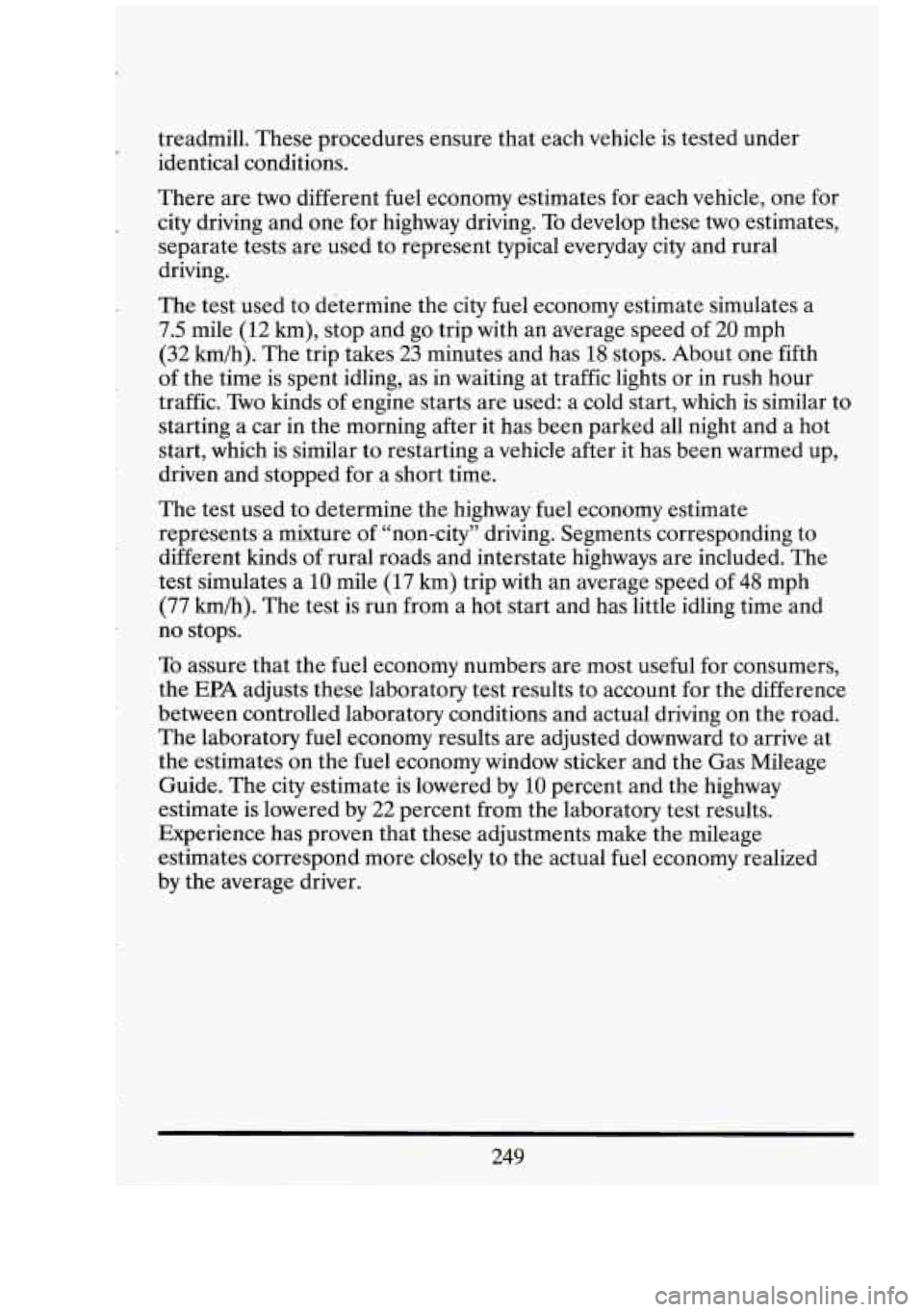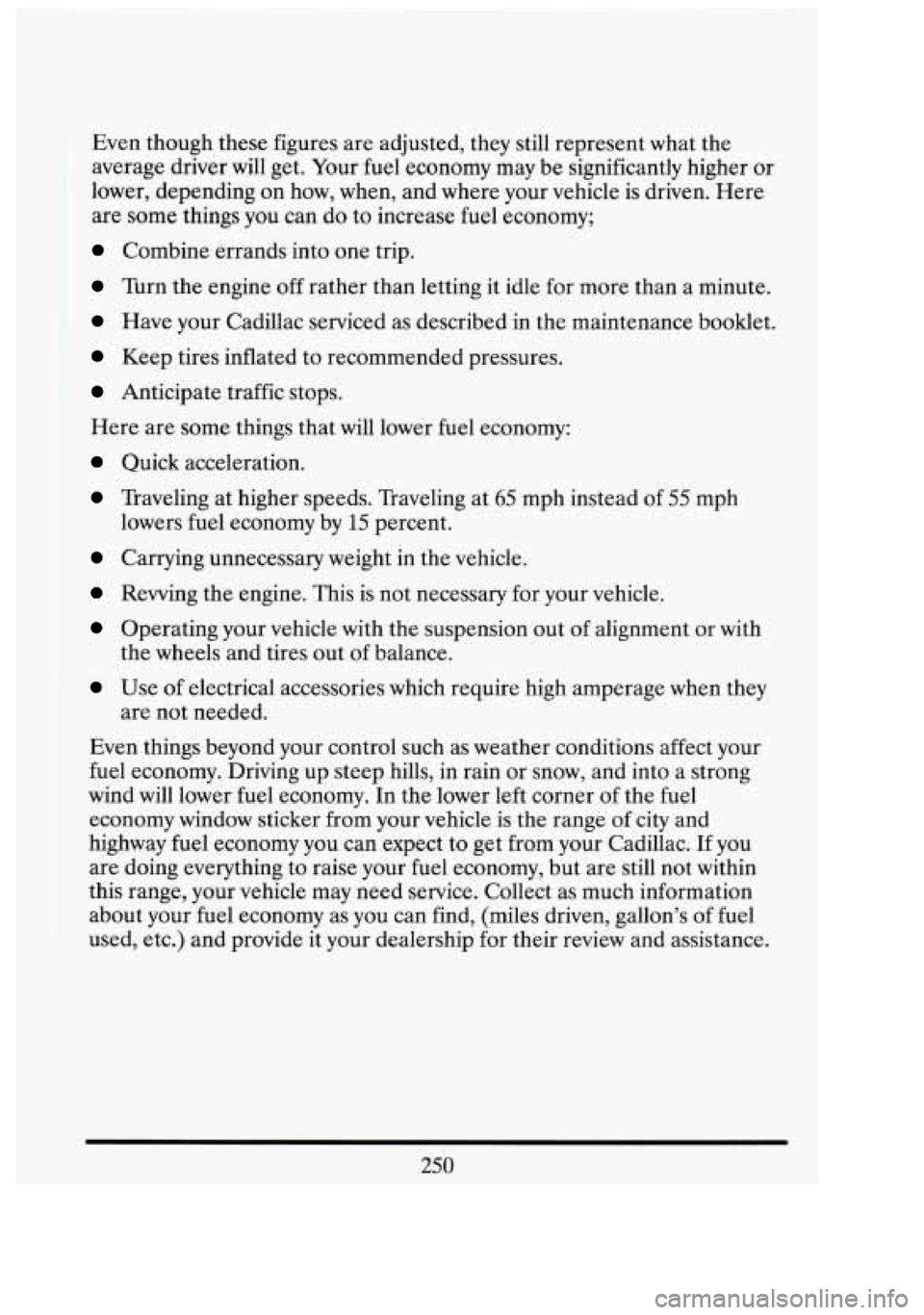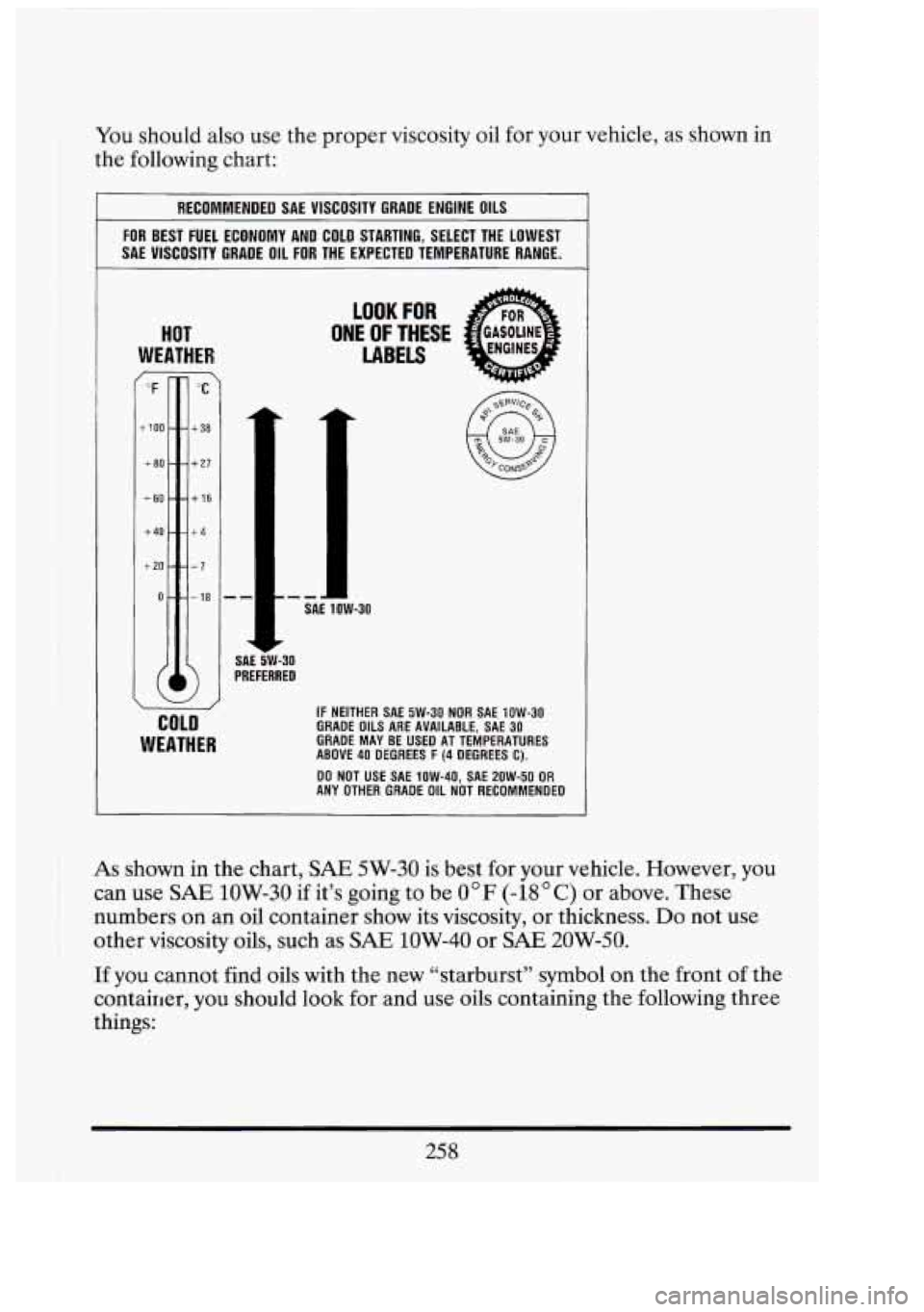Page 262 of 398

r
r
treadmill. These procedures ensure that each vehicle is tested under
identical conditions.
There are
two different fuel economy estimates for each vehicle, one Ior
city driving and one for highway driving.
To develop these two estimates,
separate tests are used to represent typical everyday city and rural
driving.
The test used to determine the city fuel economy estimate simulates a
7.5 mile (12 km), stop and go trip with an average speed of 20 mph
(32
km/h). The trip takes 23 minutes and has 18 stops. About one fifth
of the time is spent idling, as in waiting at traffic lights or in rush hour
traffic. Two kinds of engine starts are used: a cold start, which is similar to
starting a car in the morning after it has been parked all night and a hot
start, which is similar to restarting a vehicle after it has been warmed up,
driven and stopped for a short time.
The test used to determine the highway fuel economy estimate
represents a mixture of “non-city” driving. Segments corresponding to
different kinds
of rural roads and interstate highways are included. The
test simulates a 10 mile (17 km) trip with an average speed of 48 mph
(77 km/h). The test is run from a hot start and has little idling time and
no stops.
To assure that the fuel economy numbers are most useful for consumers,
the
EPA adjusts these laboratory test results to account for the difference
between controlled laboratory conditions and actual driving on the road.
The laboratory fuel economy results are adjusted downward
to arrive at
the estimates on the fuel economy window sticker and the Gas Mileage
Y Guide. The city estimate is lowered by 10 percent and the highwq
estimate
is lowered by 22 percent from the laboratory test results.
Experience has proven that these adjustments make the mileage
estimates correspond more closely to the actual fuel economy rea
by the average driver. lized
249
Page 263 of 398

Even though these figures are adjusted, they still represent what the
average driver will get. Your
fuel economy may be significantly higher or
lower, depending on how, when, and where your vehicle is driven. Here
are some things you can do to increase fuel economy;
Combine errands into one trip.
Turn the engine off rather than letting it idle for more than a minute.
Have your Cadillac serviced as described in the maintenance booklet.
Keep tires inflated to recommended pressures.
Anticipate traffic stops.
Here are some things that will lower fuel economy:
Quick acceleration.
Traveling at higher speeds. Traveling at 65 mph instead of 55 mph
Carrying unnecessary weight in the vehicle.
lowers fuel economy
by
15 percent.
Rewing the engine. This is not necessary for your vehicle.
Operating your vehicle with the suspension out of alignment or with
the wheels and tires out
of balance.
Use of electrical accessories which require high amperage when they
are not needed.
Even things beyond your control such as weather conditions affect your
fuel economy. Driving up steep hills, in rain or snow, and into a strong
wind will lower fuel economy. In the lower left corner of the fuel
economy window sticker from your vehicle is the range
of city and
highway fuel economy you can expect to get from your Cadillac. If you
are doing everything to raise your fuel economy, but are still not within
this range, your vehicle may need service. Collect as much information
about your fuel economy as you can find, (miles driven, gallon’s of fuel
used, etc.) and provide it your dealership for their review and assistance.
cl;
31
-1
ra
1-1
ra
250
Page 265 of 398
7 i
The filler door is
locked and unlocked
every time you use the
power door locks. If
pushing the power lock
switch doesn't unlock
or lock the fuel filler
door, you can use the
manual lock release
lever, in the trunk.
Move the lever to the
left to unlock the fuel
filler door.
To take off the cap, turn it slowly to the left (counterclockwise).
When you put the cap back on, turn it
to the right until you hear a
clicking noise.
NOTICE:
If you need a new cap, be sure to get the right type. Your dealer
can get one
for you. If you get the wrong type, it may not fit or
have proper venting, and your fuel tank and emissions system
might
be damaged.
252
'i La1
r
LU
-
Page 267 of 398
Before closing the hood, be sure all the filler caps are on properly. Then
just pull the hood down and close it firmly.
ENGINE OIL
If the LOW OIL LEVEL light on the instrument panel comes on, it
means you need to check your engine oil level right away.
For more.
information, see Low Oil Level light in the Index.
You should check your-
engine oil level regularly; this is .an, added reminder.
It's
a good idea to check your engine oil every time you get fuel. In order
to get an accurate reading, the oil must be warm and the vehicle must be
om level ground.
t
E
-4
254
Page 271 of 398

You should also use the proper viscosity oil for your vehicle, as shown in
the following chart:
RECOMMENDED SAE VISCOSITY GRADE ENGINE OILS
FOR BEST FUEL ECONOMY AND COLD STARTING, SELECT THE LOWEST
SAE VISCOSITY GRADE OIL
FOR THE EXPECTED TEMPERATURE RANGE.
HOP
WEATHER
7
“F
t 100 .
+80 -
+SO.
+40 -
+20 -
0-
T
”C
t 38
t 27
t 16
t4
-7
- 18
COLD
WEATHER
-- PREFERRED SAE I- 5W-30 --. SAt
. L..
LOOK FOR
ONE OF THESE
LABELS
IF NEITHER SAE 5W-30 NOR SAE 1OW-30
GRADE OILS ARE AVAILABLE, SAE 30 GRADE MAY BE USED AT TEMPERATURES
ABOVE 40 DEGREES F (4 DEGREES C).
ANY OTHER GRADE OIL NOT RECOMMENDED DO NOT USE SAE 1OW-40, SAE 20W-50 OR
As shown in the chart, SAE 5W-30 is best for your vehicle. However, you
can use
SAE 1OW-30 if it’s going to be 0°F (-18OC) or above. These
numbers on an oil container show its viscosity, or thickness.
Do not use
other viscosity oils, such as
SAE 1OW-40 or SAE 20W-50.
If you cannot find oils with the new “starburst” symbol on the front of the
container, you should look for and use oils containing the following three
things:
258
ci I
I nI
UI
tl
I
i
Page 272 of 398
0 0
0 SH or SG
“SH”or “SG” must be on the oil container, either by itself or
combined with other quality designations, such as “SWCD,”
“SH,SG,CD,” etc. These letters show American Petroleum Institute
(MI) levels of quality.
SAE 5W-30
Energy Conserving I1
Oils with these words on the container will help you save fuel.
These three things are usually included in a doughnut shaped logo
(symbol) on most containers. If you cannot find oils with the “starburst”
symbol, you should look for oils with the doughnut shaped symbol,
containing the three things noted above.
I NOTICE:
If you use oils that do not have either the “starburst” symbol or
an
API SH designation, you can cause engine damage not
covered by your warranty.
GM Goodwrench@ oil (in Canada, GM Engine Oil) meets all the
requirements for your vehicle.
259
Page 303 of 398
MFD BY GENERAL MOTORS CORP
DATE GVWR GAWR FRT GAWR
RR
THIS VEHICLE CONFORMS TO ALL APPLI-
CABLE
U.S. FEDERAL MOTOR VEHICLE
TION STANDARDS IN EFFECT ON THE
DATE
OF MANUFACTURE SHOWN ABOVE.
SAFETY,
BUMPER, AND THEFT PREVEN-
GEN GME
The other label is the Certification label, found on the rear edge of the
driver's door. It tells you the gross weight capacity of your vehicle, called
the GVWR (Gross Vehicle Weight Rating). The GVWR includes the
weight
of the vehicle, all occupants, fuel and cargo. Never exceed the
GVWR for your vehicle, or the Gross Axle Weight Rating (GAWR) for
either the front or rear
axle.
And, if you do have a heavy load, you should spread it out. Don't carry
more than
200 pounds (90 kg) in your trunk
r'tr
ni
L.
290
Page 306 of 398
r
c-
NOTICE:
Don’t let anyone tell you that underinflation or overinflation is
all right. It’s not. If your tires don’t have enough air
(underinflation) you can get:
0 Too much flexing
0 Too much heat
0 Tire overloading
Bad wear
0 Bad handling
0 Bad fuel economy.
If your tires have too much
air (overinflation), you can get:
Unusual wear
0 Bad handling
0 Rough ride
Needless damage from road hazards.
When to Check Check your tires once a month or more.
Don’t forget your compact spare tire. It should be at
60 psi (420 kPa).
How to Check Use a good quality pocket-type gage to check tire
pressure. Simply looking at the tires will not tell
you the pressure,
especially if you have radial tires
-- which may look properly inflated even
if they’re underinflated.
If your tires have valve caps, be sure to put them back on. They help
prevent leaks by keeping out dirt and moisture.
Your tire pressures are:
0 Front and Rear - 30 psi (210 kPa)
293